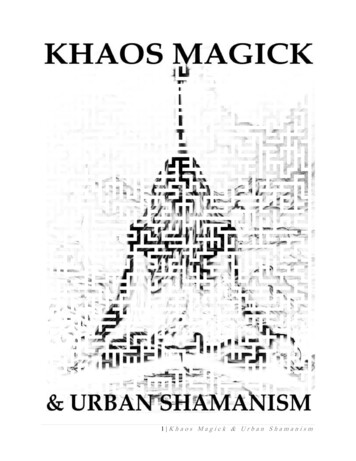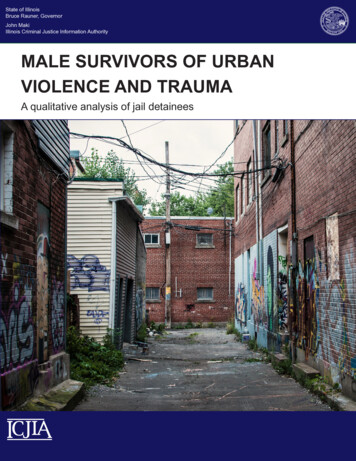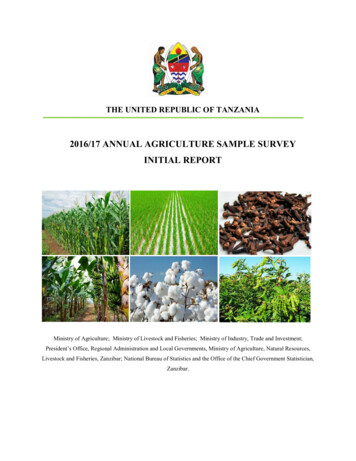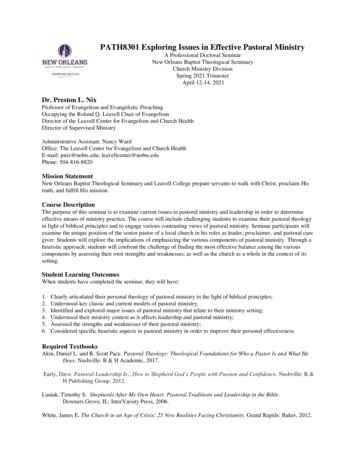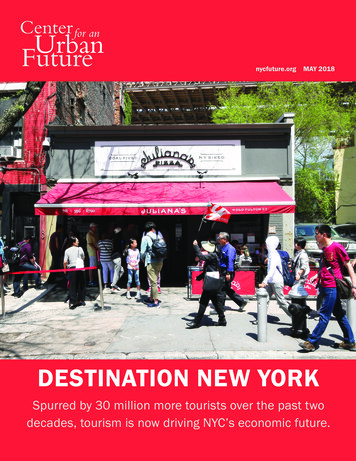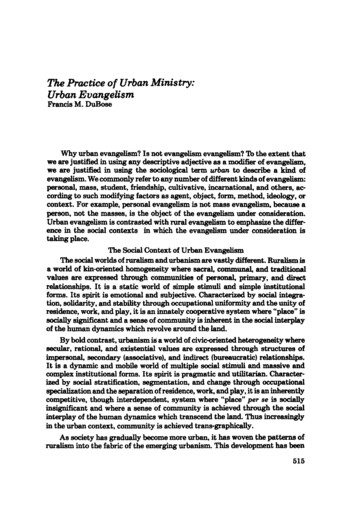
Transcription
The Practice of Urban Ministry:Urban EvangelismFrancis M. DuBoseWhy urban evangelism? Is not evangelism evangelism? To the extent thatwe are justified in using any descriptive adjective as a modifier of evangelism,we are justified in using the sociological term urban to describe a kind ofevangelism. We commonly refer to any number of different kinds of evangelism:personal, mass, student, friendship, cultivative, incarnational, and others, according to such modifying factors as agent, object, form, method, ideology, orcontext. For example, personal evangelism is not mass evangelism, because aperson, not the masses, is the object of the evangelism under consideration.Urban evangelism is contrasted with rural evangelism to emphasize the difference in the social contexts in which the evangelism under consideration istaking place.The Social Context of Urban EvangelismThe social worlds of ruralism and urbanism are vastly different. Ruralism isa world of kin-oriented homogeneity where sacral, communal, and traditionalvalues are expressed through communities of personal, primary, and directrelationships. It is a static world of simple stimuli and simple institutionalforms. Its spirit is emotional and subjective. Characterized by social integration, solidarity, and stability through occupational uniformity and the unity ofresidence, work, and play, it is an innately cooperative system where "place" issocially significant and a sense of community is inherent in the social interplayof the human dynamics which revolve around the land.By bold contrast, urbanism is a world of civic-oriented heterogeneity wheresecular, rational, and existential values are expressed through structures ofimpersonal, secondary (associative), and indirect (bureaucratic) relationships.It is a dynamic and mobile world of multiple social stimuli and massive andcomplex institutional forms. Its spirit is pragmatic and utilitarian. Characterized by social stratification, segmentation, and change through occupationalspecialization and the separation of residence, work, and play, it is an inherentlycompetitive, though interdependent, system where "place" per se is sociallyinsignificant and where a sense of community is achieved through the socialinterplay of the human dynamics which transcend the land. Thus increasinglyin the urban context, community is achieved trans-graphically.As society has gradually become more urban, it has woven the patterns ofruralism into the fabric of the emerging urbanism. This development has been515
due not simply to the fact that old ways die slowly, but to the fact that theruralism of the past embodied fundamental elements inherent in the nature ofhuman life itself. Therefore, the rural patterns of primary social relationshipsresulting in homogeneous groups characterize much of the private sphere ofurban societies. It is important to understand, however, that these social patterns which characterize the total structure of a rural society are relegated tothe private sphere in an urban world and are greatly altered by the impact of thereality of the larger urbanism. The public sphere of urban life to which allnormative urbanités must relate in a vital way is heterogeneous and is characterized by associative relationships. Vital communication in the urban context,therefore, must relate both to the public sphere of a heterogeneous mass societyand to the private sphere of homogeneous primary groups in that society, nomatter how much the latter has been altered by the former.The Theological Basis of Urban EvangelismVital communication, the stuff out of which effective evangelism is made,must have a sound theological basis in terms of urban reality. Biblical insightinto the nature of urban life is important for the right kind of attitude towardthe city. The Bible is both realistic in its recognition of the city's capability forevil and positive in its assessment of the city's potential for good and its valueas the context for the work of God. The negative picture of the city created byits association with Cain, Babel, Sodom (Gen. 4, 11, 19), and the great harlot(Rev. 17) confirms this evil capability. The city's potential for good is confirmedin the Bible through such positive pictures as the cities of refuge (Josh. 20), thecity as a desirable place (Ps. 104), the city as the place of worship (Ps. 48), thecity as the place of God's presence (Ezra 48:35; Isa. 60:14), and the city of Godtoward which Abraham journeyed and which one day would come from God outof heaven prepared as a bride adorned for her husband (Heb. 11:10; Rev. 21). Theannals of apostolic Christianity witness to the significance of the city as theplace of God's activity. It was in the city that it all happened: Bethlehem,Nazareth, Capernaum, Jerusalem, Antioch, Thessalonica, Athens, Corinth,Ephesus, Rome.Building upon this realistic and positive attitude, a theology of urbanevangelism must relate the communication of the gospel to the realities ofurban life in both the public and private spheres. The gospel must be preachedwith power and effectiveness to the urban masses, as Jesus did throughout hisministry, as Peter did on the day of Pentecost, and as Paul did on Mars Hill andin other urban contexts. At the same time, the message must be shared on apersonal basis, as Jesus did so effectively with Nicodemus, the woman at thewell, and many others; and it must be shared within small groups, as theJerusalem church did so effectively. In this way the Christian message addresses itself, on the one hand, to the massive heterogeneous and impersonalexpression of urban public life and, on the other hand, to the personal, primary,homogeneous expressions of urban private life. Consistent with this principle,516
The Practice of Urban Ministry: Urban EvangelismReview and Expositorurban evangelism must see other characteristics of urban life from this theological perspective. For example, the early church adapted institutionally to thedynamics of urban mobility and through this flexibility effectively evangelizedurban communities. Urban conflict was seen not as the enemy it is oftenpermitted to become but as the bridge of God where evangelism crosses cultureto make disciples. Urban social change becomes the very occasion for evangelistic break-through: from Jerusalem to Samaria, from Antioch of Syria to theMediterranean world of Greco-Roman culture. Even secularization—the movement away from the religious ties of the past within the ideological vacuum ofurban civic life—became an asset in the contextualization of Christianity in thefirst century. An effective evangelism for the emerging world of our urbanfuture must view urbanism from this theological perspective. Only as evangelism becomes truly indigenous to urban Ufe can it rightfully be called urbanevangelism.The Meaning of Urban EvangelismIn the preceding discussion, we have established the meaning of urban andimplied the meaning of evangelism by linking it with the communication of thegospel. It seems safest to keep evangelism close to the gospel, for the word itselfcomes from the verbal form of the Greek word for gospel. We can see thisrelationship by using the transliterated forms in rendering Romans 1:15,16: "Iam ready to "evangelize" (euaggelizô) you that are at Rome also. For I am notashamed of the "evangel" (euaggelion)" Certainly, the proclamation orsharing of the gospel—the good news of God's redemption in Christ—is theheart of New Testament evangelism. Good news is for telling, and God's goodnews is for telling with a view to making a difference. In keeping with the intentof the commissions, the definition may be expanded: Evangelism is the sharingof the gospel with the view to making disciples for Christ (Mk. 16:15; Mt. 28:19,20).Evangelism does not happen in a vacuum, however, and certainly NewTestament evangelism, which was urban evangelism, was related vitally anddynamically to the total expression of Christian Ufe and function. So musturban evangelism today be understood and practiced.Types and Methods of Urban EvangelismThe basic type and method of urban evangelism depends upon the humanfocal point in terms of the object of the evangelistic process.1. Personal evangelism focuses upon persons, and the method is conversa·tional The New Testament, especially in the Gospels, is replete with illustrations of this type and method. Whether it is planned or spontaneous, personalevangelism is especially significant in an urban society where people easilybecome lost and alienated among the urban masses. It speaks to the hurt ofdepersonalization.2. Group evangelism focuses usually upon the small group, certainly upon517
a manageable group. Its method is dialogical Small group evangelism becomesincreasingly significant in an urban society as a means of achieving communityin areas where residential community is essentially nonexistent. Thus the importance of "cell" groups is growing in an increasingly urban society. Groupevangelism may develop into a friendship, or fellowship, evangelism which has astrong nurturing orientation.3. Mass evangelism focuses upon the masses. Mass evangelism may bedirected to a moderately large group, such as a typical evangelistic worshipservice in a medium-sized church, or it may occur in a much larger group, suchas in the service of a large church or in a meeting in a large rented hall or in theopen air. The method is declarative. Urban society is a mass society characterized by mass communication. It is therefore unthinkable that mass evangelismwould be absent from urban evangelism. New Testament evangelism majoredon mass evangelism. Mass evangelism must be indigenous, however, with itsstyle and content contextualized, both in terms of urbanism itself and in termsof the unique character of the particular urban setting at hand. Simply to havelarge meetings is not necessarily mass evangelism in the New Testament sense.The Forms, Structures, and Channelsof Urban EvangelismThe basic forms through which urban evangelism was expressed in the NewTestament and through which it must be expressed today are those forms whichinhere in the nature and function of the Christian life itself. (1) Preaching grewout of the New Testament concept of proclamation and was vitally linked withapostolic evangelism. It was dynamic and adaptable to every situation, whichthe changing urban scene demanded. (2) Ministry in the New Testament was themeans through which much New Testament evangelism was accomplished.Incarnational evangelism—vital proclamation from the stance of a ministeringpresence—is an especially relevant form of evangelism for the urban context. (3)Teaching went hand in hand with proclamation in the evangelistic Ufe of theearly church (Acts 4:2, 5:42). (4) Fellowship in the New Testament had a strongevangelistic orientation. The church of Acts 2 was an evangelistic fellowship,and in 1 John 1 evangelism assumes the form of an invitation to fellowship. (5)Worship, according to Paul, can be the means of winning converts (1 Cor. 14:24,25). In fact he spoke of his evangelistic ministry in strong liturgical terms (Rom.15:15,16).These forms assume concrete expression through the contextualized structures of the institutional church. (1) The traditional church facility, the sanctuary, or auditorium, and educational plant, is the basic structure through whichmost of the above forms of evangelism have transpired traditionally. A vitalurban evangelism, however, continually challenges the church toward a morefaithful stewardship in the use of the church plant through multiple use, morefrequent and relevant use, and the sharing of facilities. (2) The house meeting518
The Practice of Urban Ministry: Urban EvangelismReview and Expositorconcept'so integral to early Christianity has been recovered in the wake of therecent urban revolution. With an almost unlimited variety of styles, from thehome fellowship to the autonomous house-church congregation, homes arebeing used in an extremely effective way around the world as a significantstructure for evangelism and nurture. (3) The street has always been one of themost flexible structures for evangelism in the city for the simple reason thatmuch vital urban communication takes place on the city street. Though theolder street "shouter" commands little audience on the modern street or opensquare today, other forms of street communication are extremely effective: themusician, the drama group, pantomime, puppets, and others. (4) Public hails,institutional facilities, and mobile units have been and continue to be effectivestructures for urban evangelism, though the style has to be evaluated continually to determine its relevance to the changing urban scene.As evangelistic forms require effective structures for visibility and actualization, so they require vital channels for illustration, clarification, contextualized communication, encounter opportunity, and the actual means by whichpersons are confronted with the claims of the gospel upon their lives. Forms arethe "what," structures are the "where," and channels are the "how" of theevangelistic process. (1) Thè personal-public encounter is the deliberately structured evangelistic channel—whether it be personal, group, or mass—in whichthe gospel message is shared verbally. (2) Normal life situations of interpersonaland intergroup relations in the daily routines of residential life, work, recreation, school life, and voluntary group associations are basic channels of evangelistic or pre-evangelistic opportunity in the urban context. These ordinary lifesituations provide some of the best points of contact for fruitful evangelism. (3)The consciously planned use of proven means of effective communication, relational activities, and ministries is the other vital channel of effective evangelism. Urban society today offers a plethora of these channels: the media (radio,television), literature (from tracts to books), audio-visuals, education (from thetraditional Sunday school to startling new curriculum designs and models),counseling, medicine (and other forms of healing), recreation, retreats, fellowship meals, friendship groups, Christian social ministries, community organizations, and many others.The choice of the term channel rather than tool has been deliberate. Tb be astrue as possible to our biblical tradition in urban evangelism today, we mustfree ourselves from the temptation of gimmickry. A manipulative evangelism,especially in the urban context, is counterproductive, if not damaging. Thegospel must be shared through relevant structures and meaningful channels.Target Groups for Urban Evangelism1. Persons in need are the object of all evangelism. The focal point of allevangelistic concern should always be persons and families in need. Selectiveevangelism, that which caters to racially, socially, and economically desirable519
people, is contrary to the spirit of Christianity. God cannot honor this perversion of the evangelistic spirit of the New Testament.2. The residential community is the most obvious target area in evangelism. Despite the breakdown of a sense of community in modern urban residential areas, the residential neighborhood is still a unit of society with commonproblems, needs, and desires. Making meaningful inroads into the life of a givencommunity offers the very best opportunity to reach people. Tb address oneselfto a specific residential area, rather than striking out after the city at large, isgood stewardship. The use of the block plan for personal visitation evangelismfollowed by group fellowship meetings is an excellent strategy which churchesare using effectively today.3. Responsive groups are a high priority. Finding responsive groups is oneway of discerning the Holy Spirit's leadership and the open door of evangelisticopportunity. This approach is biblically sound and is good stewardship. Thegroup may be a residential subcultural group. It may be a specialized group,such as students, who do not constitute an actual specific residential community. These responsive groups should be gathered for special Bible study withan evangelistic orientation.4. Responsive masses should be especially noted. In certain areas masseswill respond to certain types of gatherings. These responsive masses should bereached by the most meaningful mass structures possible. As emphasizedpreviously, however, these structures must be indigenous if mass meetings areto have maximum effectiveness with satisfying and permanent results.5. Homogeneous groups should also be especially noted. The city is anurban mosaic. Social stratification is a characteristic feature of most modernurban communities. People tend to live in homogeneous pockets: black andbrown ghettos, working-class residences, professional suburbs, southern enclaves in northern urban cultures. These subcultural residential communitiesare the nearest resemblance in modern urban society to the traditional rural,small-town, and urban residential communities of the past. It is wise stewardship to communicate with these people in the natural context of their subcultural situation. Communication often comes more easily in the context of socialhomogeneity. Small group meetings composed of people with the same subcultural identity, residential or transresidential, will make for excellent communication. This is a useful principle of contextualized communication. It must notbecome the ultimate and overriding norm of evangelistic strategy, however, forit could work at cross purposes to the gospel, which breaks down the culturalbarriers that separate people. The larger and ultimate witness must be crosscultural.6. Other target groups call for special consideration. Target groups whichfrom time to time might be more responsive than others and therefore theobject of special evangelistic consideration are children, youth, single adults,520
The Practice of Urban Ministry: Urban EvangelismReview and Expositorthe elderly, workers, business groups, students, professional people, artists,entertainers, athletes, migrants, street people, the institutionalized, the disabled, and the disadvantaged.New Testament urban evangelism was an evangelism of the Spirit. So itmust be today. Everything in the evangelistic program may be right, but unlessthe Holy Spirit breathes upon it, it will not work. Sociological analysis, theological clarity, and methodological soundness must be instruments of God's Spirit,for the Spirit is the agent of evangelism. As the Spirit moved through dedicatedchannels in the vital urban scene of the apostolic age, so the Spirit can movetoday. So the Spirit is moving today!521
sCopyright and Use:As an ATLAS user, you may print, download, or send articles for individual useaccording to fair use as defined by U.S. and international copyright law and asotherwise authorized under your respective ATLAS subscriber agreement.No content may be copied or emailed to multiple sites or publicly posted without thecopyright holder(s)' express written permission. Any use, decompiling,reproduction, or distribution of this journal in excess of fair use provisions may be aviolation of copyright law.This journal is made available to you through the ATLAS collection with permissionfrom the copyright holder(s). The copyright holder for an entire issue of a journaltypically is the journal owner, who also may own the copyright in each article. However,for certain articles, the author of the article may maintain the copyright in the article.Please contact the copyright holder(s) to request permission to use an article or specificwork for any use not covered by the fair use provisions of the copyright laws or coveredby your respective ATLAS subscriber agreement. For information regarding thecopyright holder(s), please refer to the copyright information in the journal, if available,or contact ATLA to request contact information for the copyright holder(s).About ATLAS:The ATLA Serials (ATLAS ) collection contains electronic versions of previouslypublished religion and theology journals reproduced with permission. The ATLAScollection is owned and managed by the American Theological Library Association(ATLA) and received initial funding from Lilly Endowment Inc.The design and final form of this electronic document is the property of the AmericanTheological Library Association.
evangelism is especially significant in an urban society where people easily become lost and alienated among the urban masses. It speaks to the hurt of depersonalization. 2. Group evangelism focuses usually upon the small group, certainly upon 517 . a manageable group. Its method is d


